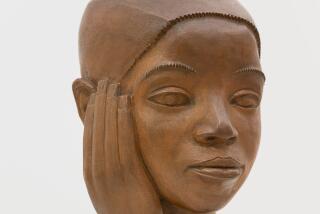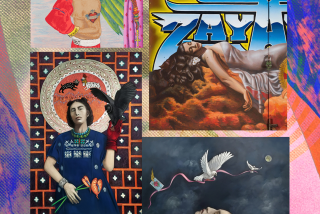L.A. artist Betye Saar wins art colony medal, joining elite club
- Share via
Los Angeles artist Betye Saar has won the 2014 Edward MacDowell Medal, a lifetime achievement award given by America’s oldest artists’ colony, joining an elite roster of honorees dating back to 1960.
She’ll receive her award Aug. 10 in ceremonies on the MacDowell Colony’s 400-plus acre campus in Peterborough, N.H. The cast-bronze medal bears the image of the man who founded the colony in 1907 as a gathering place where artists in diverse disciplines could mingle while pursuing their individual work.
Saar, 87, joins a diverse list of MacDowell medalists that includes last year’s winner, Stephen Sondheim, and Sonny Rollins, Aaron Copland, Leonard Bernstein, Edgard Varese and Steve Reich among composers, playwright Edward Albee, architect I.M. Pei and writers Philip Roth, Thornton Wilder, Robert Frost, Joan Didion and Alice Munro. Winners can come from any of seven categories -- architecture, visual art, music composition, theater, writing, filmmaking and interdisciplinary art.
CRITICS’ PICKS: What to watch, where to go, what to eat
Other Southern California honorees include animated filmmaker Chuck Jones (1997) and architect Thom Mayne (2008). The other living visual art medalists are Nan Goldin, Kiki Smith, Robert Frank, Ellsworth Kelly and Jasper Johns.
Saar’s “exquisite collages have posed questions, challenged presumptions and have never failed to demonstrate her unique aesthetic sensibility,” Lowery Stokes Sims, curator of New York’s Museum of Arts and Design, and chairman of this year’s selection panel, said in this week’s announcement of Saar’s medal. “While her presence might be seen as primarily West Coast-focused … she has impacted a whole new generation nationally for whom polemics are a concern, and shown them how to do it right.”
Novelist Michael Chabon, who is chairman of the MacDowell Colony, described Saar’s work as “scale models” that are “inescapably recognizable as our own broken world...mapping it with fierceness, a sense of play and…wild accuracy.”
Saar, a Los Angeles native, began as a printmaker after earning a graphic design degree from UCLA in 1949, but found a new path when she saw an exhibition of Joseph Cornell’s boxed assemblages at the now-defunct Pasadena Art Museum in 1966.
PHOTOS: Arts and culture in pictures by The Times
Her work has included boxed assemblages of figures and other objects, as well as sculptures and room-sized installations. Reviewing 1990s shows at the Santa Monica Museum of Art and the California African American Museum, then-Los Angeles Times critic William Wilson called Saar “an unassuming master of resonant suggestions that reverberate with wisdom,” and described her method as “using precious junk to talk about her life, which happens to be the life of an African American woman. Using stereotypes like Aunt Jemimah and Uncle Tom, she has told us that prejudice turns everyone into corroded caricatures.”
A key piece was her 1972 small assemblage “The Liberation of Aunt Jemima,” in which she armed the stereotypical black mammy from pancake mix boxes with a rifle as well as a broom. It’s in the collection of UC Berkeley’s art museum. “I turned Aunt Jemima into a warrior,” Saar told the Los Angeles Times in 1997.
Her work, including several pieces completed this year, is currently on view in “Redtime EST,” a show unified by Saar’s use of the color red at New York’s Michael Rosenfeld Gallery. The website of Roberts and Tilton, the Culver City gallery that represents her, says a solo show by Saar is scheduled for 2015 at Museum Het Domein in Sitttard, the Netherlands.
ALSO:
Art review: Betye Saar at Roberts and Tilton
Building shelter in the storm of alienation and exile
MORE
PHOTOS: Hollywood stars on stage
CHEAT SHEET: Spring arts preview 2014
PHOTOS: Arts and culture in pictures
More to Read
The biggest entertainment stories
Get our big stories about Hollywood, film, television, music, arts, culture and more right in your inbox as soon as they publish.
You may occasionally receive promotional content from the Los Angeles Times.











